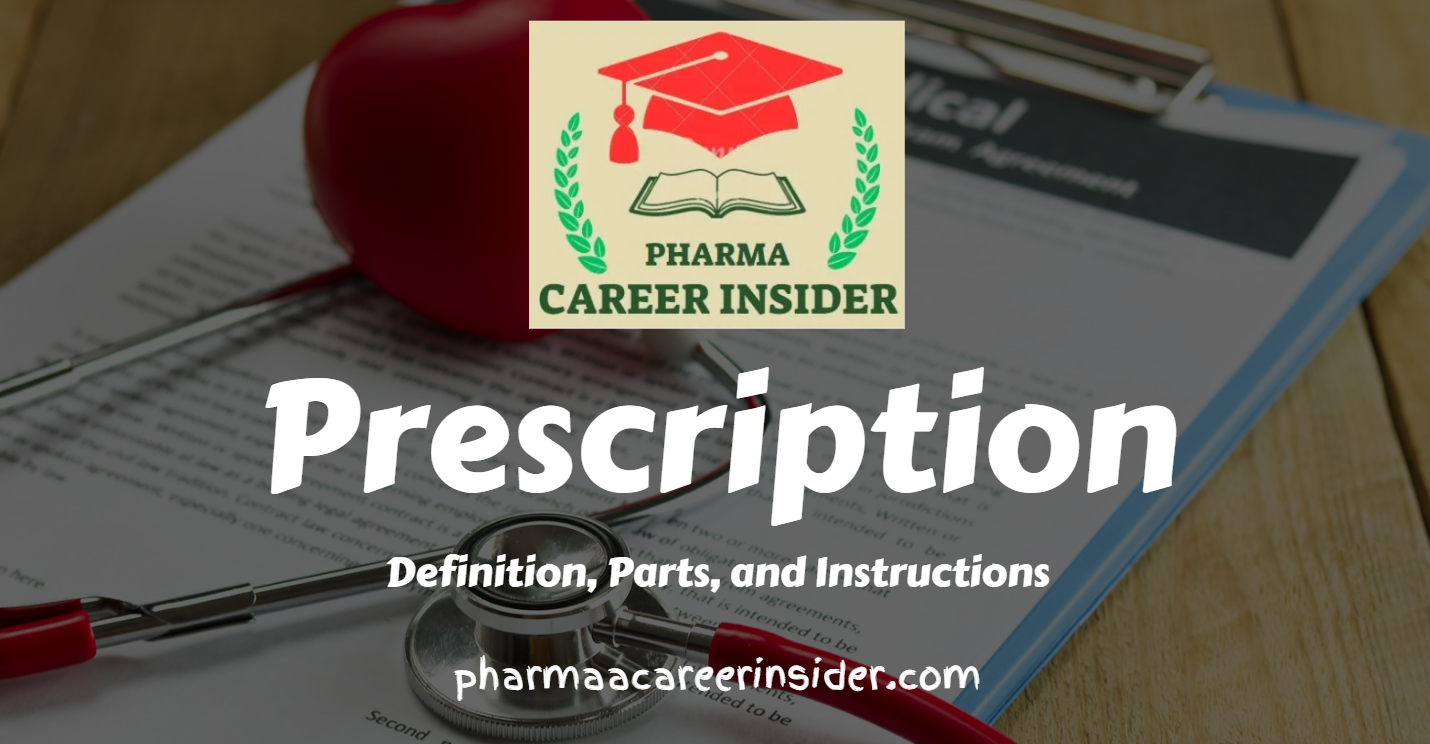A prescription is an order written by a physician, dentist, veterinarian, or any other registered medical practitioner to a pharmacist to compound and dispense a specific medication for the patient.
Essential features of a prescription
• Directions are given to the pharmacist about what type of preparation (tablet, powder, mixture, etc.) is to be prepared.
• Its contains directions for the patients, the dose of the drug, the dose interval, and how it is to be taken.
• The Prescriptions are generally written in the Latin language so that the prescription remains unknown to the patients to avoid self-medication.
Parts of a Prescription
A typical prescription consists of the following parts:
1. Date
The date on the prescription helps the pharmacists to know when the medicines were last dispensed if the prescription is brought for dispensing of the prescription. In the case of habit-forming drugs, the date prevents the misuse of the drug by the patient.
2. Name, age, sex, and address of the patient
By name and address, the patient and the prescription can be identified. The age and sex of the patient are especially required for child patients to check the prescribed dose.
3. Superscription
It is represented by a Latin symbol ℞, an abbreviation of the Latin term ‘recipe’
which means ‘take thou’ or ‘you take.’
[N.B. In the olden days, the symbol was considered to have originated from the sign of Jupiter, the Greek
God of healing. This symbol was employed by the ancient in requesting God for the quick recovery
of the patient.]
4. Inscription
This is the main part of the prescription. It contains the names and quantities of the
prescribed medicaments. The medicament may be official preparation or nonofficial preparation. If
it is an official preparation (i.e., from pharmacopeia or formulary), then only the name of the preparation is written.
e.g., Piperazine Citrate Elixir IP.
If it is a nonofficial preparation, then the quantity of each ingredient will be given. The type of preparation will also be given.
3. Superscription: It is represented by a Latin symbol ℞, an abbreviation of the Latin term ‘recipe,’ which means ‘take thou’ or ‘you take.’ [N.B. In the olden days, the symbol was considered to have originated from the sign of Jupiter, the Greek God of healing. This symbol was employed by the ancient in requesting God for the quick recovery of the patient.]
4. Inscription: This is the main part of the prescription. It contains the names and quantities of the prescribed medicaments. The medicament may be official preparation or nonofficial preparation. If it is an official preparation (i.e., from pharmacopeia or formulary), then only the name of the preparation is written.
e.g., Piperazine Citrate Elixir IP.
If it is a nonofficial preparation, then the quantity of each ingredient will be given. The type of preparation will also be given.
e.g. Sodium bicarbonate 3g
Simple Syrup 6ml
Purified Water q.s. 100ml
Parts of Prescriptions
The inscription of prescriptions containing several ingredients is divided into the following parts:
(a) Base: The active medicaments intended to produce the therapeutic effect.
(b) Adjuvants: These are included either to enhance the action of the drug or to make the preparation more palatable.
(c) Vehicle: It is the main carrier of the drug. In liquid preparations, drugs are either dissolved or dispersed in the vehicle.
5. Subscription
In this part, the prescriber gives directions to the pharmacist regarding the dosage form to be prepared and the number of doses to be dispensed.
6. Signatura
It is usually written as ‘Sig.’. The instructions given in the prescription should be written on the container’s label so that the patient can follow them. The instructions may include:
(a) The quantity to be taken
(b) The frequency and timing of administration of the
(c) The route of administration
(c) The special instruction (if any)
7. Renewal instructions
The prescriber indicates in every prescription whether it should be renewed, and if renewed, for how many times. It is very important, particularly in the case of habit-forming drugs, to prevent its misuse.
8. Signature, address, and registration number of the prescriber
The prescription must be signed by the prescriber by his / her hand. His/her address and registration number should be written in the case of dangerous and habit-forming drugs.
An example of a typical prescription is given as follows:
Name of the hospital
Address of the hospital
Name: patient`s name Age: patient`s age Sex: patient`s sex Address: patient`s address
Rx…………………….. (superscription)
Sodium bicarbonate 3g
Inscription – Compound tincture of cardamom 2ml
Simple Syrup 6ml
Purified Water q.s. 90ml
Fiat moisture. (Subscription)
Sig. Cochleare magnum ter in die post cibos sumenda. (Signatura) Refill: ________ Dr. Deepak Rajput (e.g.) Regn. No. ……….




